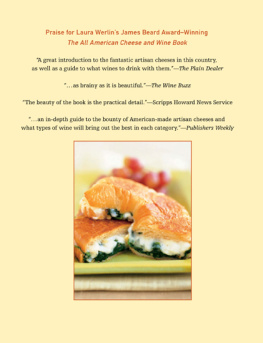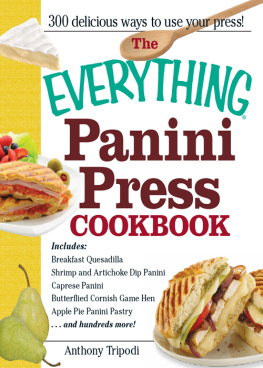Copyright 2008 by Carlo Middione
Photography 2008 by Ed Anderson
All rights reserved.
Published in the United States by Ten Speed Press, an imprint of the Crown Publishing Croup, a division of Random House, Inc., New York.
www.crownpublishing.com
www.tenspeed.com
Ten Speed Press and the Ten Speed Press colophon are registered trademarks of Random House, Inc.
Cover design by Toni Tajima
Food and prop styling by Jenny Martin-Wong
Library of Congress Cataloging-in-Publication Data
Middione, Carlo.
Panini / Carlo Middione; photography by Ed Anderson.
p. cm.
Summary: A collection of fifty recipes for traditional and modern-day panini (Italian sandwiches)Provided by publisher.
Includes index.
eISBN: 978-1-60774-380-4
1. Panini. 2. Cookery, Italian. I. Title.
TX818.M54 2008
641.5945dc22
2007039774
v3.1
CONTENTS
PREFACE
Many kindred panini lovers have helped and encouraged me in my panini perambulations. On many road trips and around countless tables, favored companions have been not only family and friends but also panini partners. My wife, Lisa, is always at the top of my list of helpersand in many more ways than just being my panini partner. Nothing good I do, or could do, could be done without her. Among many friends and peer eaters who have given advice, and recipes, and panini themselves, Anna Tasca Lanza and Nancy Harmon Jenkins stood out in their enthusiasm for this book and shared their favorite panini eaten over many miles of road and at the table.
I thank Lorena Jones of Ten Speed Press for letting me write down many delicious panini recipes. Thanks also goes to my editor, Brie Mazurek; Ed Anderson, our photographer; Jenny Martin-Wong, our food stylist; and Toni Tajima, our designer.
So many others have provided me with information that made it easier, and certainly fun and rewarding, for me to write down the recipes, and to you all, many, many thanks. And buon appetito!
INTRODUCTION
Charming company turn lowly sandwich into rich banquet.
C HARLIE C HAN IN R ENO (1939)
SINCE TIME IMMEMORIAL, there have been sandwiches; they simply were not called that. A piece of meat folded over a blade of grass or a shoot, a root, or a nut, an edible leaf containing a grub or tiny raw fish, and ecco, you have what we call a sandwich. In time, as food became more complex to prepare and quite diverse, thanks to socialization, agriculture, and the never-ending quest for whats new in taste, more ingredients were at hand to try. Not all experiments are planned, or follow protocol set by others that eventually leads to a conclusiona theory that gets proved. No. When it comes to sandwiches, or in our case panini, you will see that it must have been happenstance that created a nourishing, and novel, way to eat more than one item at a time that is, at the same moment, the ultimate portable feast.
You can put a panino in your pocket and set off to see the world, never having to worry about hunger, or brave the wilds to bag game, or plow the fields to generate crops. Ever since Rabbi Hillel, the great Jewish teacher who lived about one hundred years before Christ, put haroseth (a delicious concoction of fruit and nuts) between pieces of matzo, sandwiches have been abundant but strangely neglected in literature and certainly in most cookery books from all ages. Here, we correct that.
Most often credited with first putting some meat between two pieces of bread is the great gambler John Montagu, fourth earl of Sandwich, in the mid-eighteenth century. It was said that he created this portable snack to satisfy his hunger while he gambled, so he wouldnt have to leave the thrill of the game. From primordial times to John Montagu to panini is circuitous to be sure, and not in the scope of this book.
TRAMEZZINI
In Mussolinis time, before World War II, panini were seen as too pedestrian for a great nation to munch on, so they were banned as such. Of course, enterprising Italians came up with a new word, tramezzini (in-between things), and a daintier look. These are outrageously popular in bars and osterie in Italy, accompanied by the inevitable glass of wine, or maybe a coffee or dense hot chocolate. They are a little like what we call tea sandwiches, just slightly bigger.
A MOVEABLE FEAST
This book is about making and eating paniniItalian-style sandwiches. Who but the Italians eat with such exuberance and have such a love of ingredients (and are so fussy and determined about getting the best of them)? Who but the Italians cook with such a sense of adventure that they have raised a simple meal like a sandwich into an edible art form?
In Italy, there must be tens of thousands of panini variations. Many of them probably originated as a slice or chunk of bread eaten alternately with a bit of something else, most probably semi-hard cheese, but also other things such as cured meat, dried fish, or fruit. Cheese travels well or sits deliciously on a table with nothing to conserve it but the salt it contains, getting flavor and character from milk and the loving skilled hands of the cheesemaker. The same is essentially true of cured meats.
From Roman times, meals of bread accompanied by bits of cheese and meat for flavor were called companatico, from the Latin cum panis, with bread. The word companion has the same root, sharing, in this case, to go with bread. In Italy still, olives, prosciutto, cheeses, and salted fish are known as companatico ingredients. Voglio comprare un po di companatico. I want to buy a little something to go with bread. Usually these ingredients are salty or highly flavored because bread, even in its most robust form, benefits from more assertive partners. Today, we enjoy these traditional panini fillings, but also more contemporary ones like roasted vegetables, freshly cooked or canned fish, even fruit, chocolate, and ice cream!
At some point, the need arose for food that was portable. Or, when one had more bread than filling on hand, someone eventually thought to put both to good use by capturing small amounts of filling between two pieces of bread. And so panini were born. As the sandwich became more popular, of course a type of bread evolved just for it. The Italian word for bread is pane. A small bread or roll is panino. More than one roll is panini. The rest you can imagine.
PANINI EXPLAINED
If you think panini are closed, invariably grilled sandwiches, you will be amazed by the variety, as revealed in this book. The term panino, as Im using it, is the generic name for sandwich in Italian. There are some sandwiches in this book that are open-faced, some that are not grilled, and some on unlikely styles of bread. The idea that panini must be grilled and pressed is strictly American. In Italy, not all panini are grilled, and many would suffer if you did grill them. There, grilled panini are especially popular in fall and winter, and when you need to be comforted. But in the height of summer, a non-grilled tomato and mozzarella panino might be the choice of many eaters.
QUANTO BASTA











